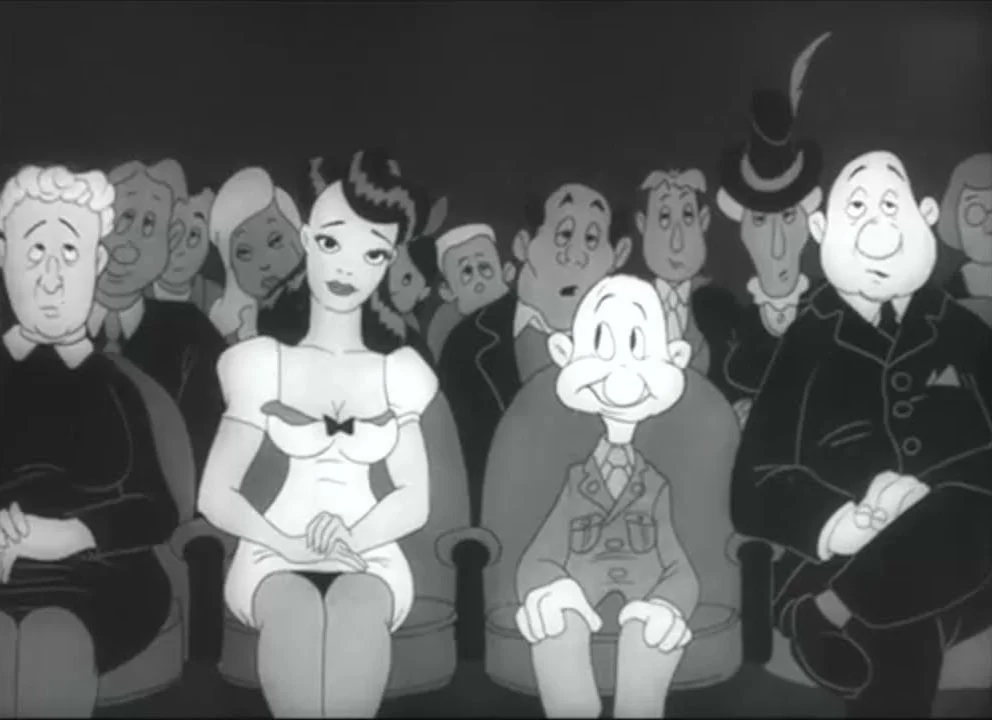Considering the various ways that one could visually adapt Imre Madách’s 1861 play The Tragedy of Man - a widely renowned icon of Hungarian literature - Marcell Jankovics’ 2011 animated film of the same name makes a strong case for animation as the perfect medium to do so. Beginning in 1988, the film’s production was halted the following year due to major societal and governmental changes in Hungary after the crumbling of Soviet power in the Eastern Bloc (Ito, Astell). Having spent years raising funds to resume production incrementally, Jankovics saw his work to its completion over two decades later in 2011, its painstaking production process almost mirroring the themes of the work upon which it is based. The journey paid off immensely, as the final film proved to be what many deem a masterclass of both hand-drawn animation and literary adaptation. In viewing the film’s form, specifically its artistically crafted visuals and incorporation of various unique art-styles, this blog analyses how the story and themes that Madách presents are highlighted and powered by the animated medium through which Jankovics relays in the narrative events.
Read MoreA school shooting is every parent’s worst nightmare. Unfortunately, this nightmare is real for many parents in the United States. According to researchers at Education Week, in 2024, there were 39 recorded school shootings resulting in injuries or death; so far in 2025, there have been 3 events relating to gun violence on school grounds in the US (“School Shootings Over Time”). The persistence of school shootings in the US and the fear and grief they cause are extremely devastating to students and affected families. Communities like Mothers Against Gun Violence, Americans for Responsible Solutions, and Sandy Hook Promise demand change for schools and gun legislation. In this blog, I will analyze the use of colour and sound in Will McCormack and Michael Govier’s animated short If Anything Happens I Love You (2020), reflecting on how these elements of style convey a harrowing outlook on school shootings
Read MoreThe Society for Animation Studies (SAS), one of the world’s most well-known and popular international organizations dedicated to the study of animation history, theory and practice, holds an annual conference at locations throughout the world each year, where members present their recent research. The 36th Annual Society for Animation Studies conference took place between 7th-10th July 2025, hosted in Elephant & Castle, London, by the Screen School, London College of Communication (LCC), University of the Arts London (UAL). This year’s conference title was ‘Sustaining Animation’, and was inspired by UAL’s key values of climate, social and racial justice, and equality, diversity, and inclusion.
Read MoreA recurring motif in Japanese animation and contemporary climate fiction animation is the misuse of technology by fictional scientific and militaristic authorities, which in the fictional narratives leads to severe disaster, often with ecological and environmental consequences. In this context, “living weapons” – powerful beings created by science whose impact and abilities are reminiscent of weapons of mass destruction – are particularly potent. Living weapons are “fantasy characters who exist in alternative worlds and become embroiled in implausible plot lines” (Swale 2020, 1999). As archetypes, they prompt reflection on the depiction of cultural notions of catastrophe, particularly environmental catastrophe, and are often explored as symptomatic of deep-rooted and durable cultural anxieties about disastrous scientific incidents.
Read MoreIn 2020, the American streaming giant Netflix acquired global streaming rights (excluding the United States and Japan) for the films of Studio Ghibli. Audiences have since been enjoying a collection of the world-famous Ghibli animation films from My Neighbor Totoro (Hayao Miyazaki, 1988), Spirited Away (Hayao Miyazaki, 2002), and Ponyo (Hayao Miyazaki, 2008) for nearly 5 years. But there was one exception. The 1988 film Grave of the Fireflies, directed by the co-founder of Studio Ghibli Isao Takahata was on the waiting list for 4 years, before finally arriving onto the platform on September 16, 2024.
Read MoreAs a media form, animation has the unique ability to render immaterial realities and unfamiliar experiences visually in a manner inaccessible to live-action cinema. In this way, animation can represent the unrepresentable, creating a rare opportunity for either the disruption of hegemonic discourses, such as through the visualisation of silenced perspectives, or a repackaged reiteration of them. Animation can provide a vehicle for graphic political criticism, augmenting the way things are represented through artistic means: such as by exaggerating certain characteristic features of a political class or actor through cartoon aesthetics. A prime example of this can be found within the Who is a Refugee? animation featured on the United Nations High Commissioner for Refugees (UNCHR) YouTube channel, which represents the journey of an unnamed family from an unspecified nation as they transition into refugee status.
Read MoreDirected by Bibo Bergeron, the computer-animated film A Monster in Paris (2011) follows the story of Francoeur, a chemically mutated flea, as he explores the city of Paris, befriends Lucille and her two friends, and hides from the danger that is the fear of those who do not understand him. Set during the flooding of the Seine River (1910), Bergeron’s film carries various themes of love and friendship, though darker messages hide beneath the surface of this captivating Europe-set narrative.
Read MoreIn 2019, MORE Productions was contemplating its first animated film project. Having worked on live-action features like The Ticket (2016) with Dan Stevens and Martin Scorsese’s Silence (2016), MORE’s co-producers Mark Rodgers and Mandi Hart knew the world of live-action filmmaking well. They also knew it was not the best creative choice for the story they were seeking to tell - the story of 21 men (twenty Coptic Egyptians, one Ghanaian) kidnapped, tortured and ultimately martyred by ISIS in an infamous video published on February 15, 2015.
Read MoreLast week the BAFTSS Animation SIG presented another stellar online event. This time the SIG offered to explore the uncanny territories of posthumous and posthuman animation. Organized by Dr. Sam Summers (Middlesex University) and featuring works-in-progress by a doctoral student Alice Giuliani (University of West London) and Dr. Christopher Holliday (King’s College London), the Posthumous & Posthuman Animation seminar took place on Zoom on May 10th 2023.
Read MoreIt seems that even film fans are becoming increasingly aware of the huge significance China is going to play in the next few decades of popular culture. In a global media landscape otherwise dominated by the United States, the huge significance of both the Chinese box office and the Chinese government’s cultural politics is shaping the fortunes of the globalised media industry.
Read MoreThe American government utilized the rising popularity of animated films during the 1930s and 1940s to curate several propaganda shorts during the Second World War. The Private Snafu series aired from 1943-1946 and followed the eponymous Private Snafu whose mishaps functioned as a cautionary tale against misbehaving in the military.
Read MoreIn 1965, the Czech draughtsman, book illustrator, puppet and toy designer, painter, animated film-maker and sculptor Jiří Trnka released his last short animation film Ruka/The Hand (1965). The silent 18 minute animation delivers a powerful and chilling dynamic; allegorically and metaphorically representing the influence of the communist political regime on the freedom of people through the framing of Trnka as the main character (a harlequin) and the accompanying image of the hand, which overpowers harlequin’s agency.
Read MoreThe 1973 animated adaptation of Stefan Wul’s 1957 novel, Oms En Serie, recounts the enslavement and subjugation of the ‘Oms,’ (a term that is phonetically indistinguishable from the French word for men, hommes), by giant blue humanoid aliens, the ‘Draags.’
Read MoreIn this blog post I will explore the ways in which Jay Z’s 2017 music video ‘The story of O.J’ (2017) evokes the problematic politics of representation in animation, and the damaging effects that these representations have historically had on understanding of American black identity and culture.
Read MoreNineteen Eighty-Four (1949) as a novel has taken on a life divorced from its creator. In political parlance, the book—or terms from it—have been used to herald apocalyptic prophecies, no matter the political affiliation. For example, recently in the United States, Senator Josh Hawley, R-MO, used the term “Orwellian” to describe a publishing house’s cancellation of a book contract.
Read MoreJessica Ashman is a BAFTA in Scotland award-winning artist who works in animation, music, performance and arts education. In 2014 she graduated from the Royal College of Art with a MA in Animation and her work has been supported by Animate Projects, Jerwood Visual Arts Bursary, Arts Council England, UK Film Council and Channel 4's Random Acts.
Read MoreIn today’s visual culture, animation is at an interesting turning point, poised between fiction and fact, perhaps combining the two. We are increasingly confronted with ubiquitous animated images, videos, and gifs, for example, on smartphones, computers, in airplanes, doctors’ offices, schools, and many more, which are all used uncritically to represent or express real events, feelings, processes, and interactions.
Read MoreThere is no accounting for taste at the best of times, but this past month’s constant stream of dire global pandemic news and projections has wreaked havoc on streaming algorithms, as quarantined audiences scramble to keep themselves occupied with a wide variety of new content. While many have opted to dive headfirst into big cat-themed true crime, others are eschewing escapist entertainment in favor of a morbid fascination with newly relevant fictional contagion narratives.
Read MoreWith the Global Climate Strike, Greta Thunberg, environmental disasters and the rise of Extinction Rebellion, it seems like this is the decade when the world is waking up to the environmental emergency. However, it is clear that the research that climate-induced natural catastrophes and multiple activist organisations have existed for decades (especially if we cast our minds back to the 1960s), without leading to a real sense of urgency, albeit due to enormous efforts by big polluters to deny the science. This is where animation comes in. Data from hardworking scientists and policy analysts have illustrated the rapid destruction of our natural habitat for decades. But today, media – and animation in our case – has been able to obtain a much stronger impact on civil society – and, by extension, politicians – and amplify the voices of those who have been too easily dismissed in the past.
Read MoreThe intersection of fantasy and animation is increasingly also an intersection of nationalities and cultures. The world’s best known animation studios often look beyond their own cultures for inspiration, exploring and representing people, mythologies and folklore from across the globe. Japan’s Studio Ghibli, for example, frequently adapt Western sources, creating fantasy-inflected variations on European countries (Howl’s Moving Castle [Hayao Miyazaki, 2004]) or indeterminate settings bearing both Japanese and European influence (Kiki’s Delivery Service [Hayao Miyazaki, 1989]; Arrietty [Hiromasa Yonebayashi, 2010]; When Marnie Was There [James Simone & Hiromasa Yonebayashi, 2014]).
Read More



















